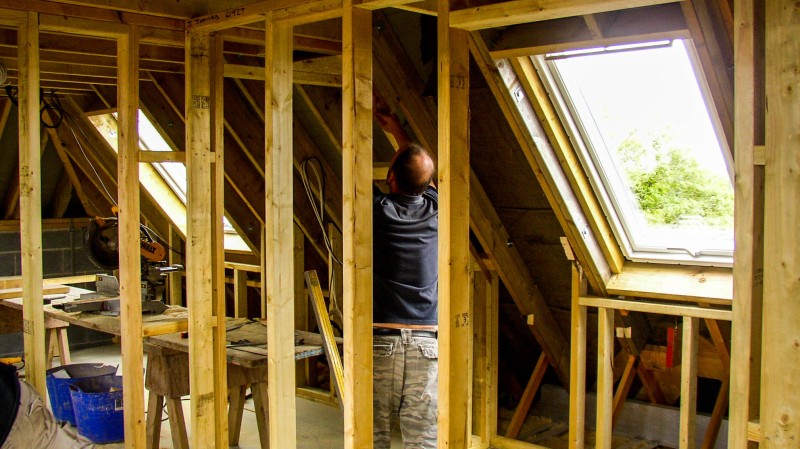You are here: Extend out into the Garden or up into the Attic?
Almost every family is faced with the challenge at some stage in its growth that says the family needs more space than its current home offers in its present form. When that dilemma presents itself, the first decision which must be made, is whether you move to a larger house or stay put and extend the present property
The two main arguments are probably going to be around lifestyle and finance. On the lifestyle side the discussion will be around how settled the family is in the area where you live at present. The children’s school, their friends and other local activities as well as your own life choices, not to forget that moving house is one of the most stressful events in anyone’s life. Moving house is also expensive, with estate agents fees, surveys, stamp duty, conveyancing and removals all adding up to a sizable amount, none of which can be recouped. Building an extension to your existing house at least adds value to that property and can hopefully be recouped on the sale of the house at a later date.

Assuming that the decision is to extend, the next decision is, do you extend out or up. If you extend out there are both pros and cons;
Pros;
- You can choose where to build, side or rear
- You can build an extension of any size which your garden allows
- Your extension can be anything you want, more living space, extra bedroom, kitchen extension, utility room or extra toilet
- You can build either single or two storey, giving the option to add a further bedroom or extra bathroom on top of your new ground floor extension
Cons;
- Extending your internal space will mean reducing your outdoor space
- You will lose potentially valuable garden space
- If a side extension, you may lose a valuable parking space, which might cause planning issues
Converting attic space, equally has pros and cons;
Pros;
- Attic space is usually dead space, used for storing things we may or may not use one day
- An attic conversion may well not require planning permission as the work may possibly be carried out under permitted development
- Won’t eat into prime garden space
Cons;
- Floor area will be restricted to the footprint of the house
- May require Party Wall agreements with neighbours
- Will require space from existing house for stairway to new room
Having looked at the practical and lifestyle issues, the next consideration is the comparable costs. With both options, the size and complexity of the new build will have an effect on the ultimate cost. Both kitchen and bathroom furniture and fittings add substantially to the cost of an extension in comparison to a simple extra bedroom but would add significantly more value by comparison.
A singe storey extension could cost upwards of £1,500 per sq. metre, meaning that a 5m by 4m extension would cost around £24,000 and would potentially add around 15% to the property value. Similarly, a two storey extension would cost around £2,600 per sq. metre, with a twenty sq. metre extension costing in the region of £56,000, adding a potential 20% to the value of the property.
A loft conversion, similarly, could add in the region of 20% to the property value, however the build costs vary tremendously depending on the style and configuration of the build. The size and type of your loft conversion are the two most influential factors affecting the overall cost. Based on a 30sq.meters loft space;
- A shell loft conversion might cost upwards of £25,000
- A Velux loft conversion could cost £25,000 to £30,000.
- A dormer conversion is understandably more expensive and can cost in the region of £40,000 to £60,000.
- Hip-to-gable dormer conversions, can cost £45,000 – £65,000
- A Mansard* conversion can cost somewhere between £45,000 and £70,000.
A bungalow normally has a larger ground floor area than other house types and on that basis, a loft conversion of around 50sq.meters can often be achieved, which would have a cost of around £65,000 – £85,000.
Both options offer scope for innovative design rather than following a standard format, although both would have a higher cost implication. Building an extension gives the opportunity to include a reconfiguration of existing accommodation, perhaps including a more open plan configuration of your living accommodation to allow more transfer of daylight into the property. An imaginatively designed loft conversion can, likewise, result in an area which not only gives extra space but provides an aesthetically pleasing configuration to your new master suite or home office space.
When planning to increase the square meterage of your property, it is also worth considering peripheral issues such as heating or insulation. A new extension which is designed to maximise the daylight in the property may in fact not have a great deal of new wall space for radiators and likewise an attic conversion may not offer you much wall space suitable for mounting central heating radiators and these may both lend themselves to installing underfloor heating rather than extending your existing central heating. It is also worth considering whether your present boiler would cope with extra radiators. Regardless of how you heat your new accommodation, it is important to maximise the insulation in the area so that you keep both your heating costs and your carbon footprint both to a minimum.
As well as generally being less expensive than building an extension, a loft conversion will take less time to complete and cause less disruption. Time scales will vary depending on the size and complexity of your loft conversion but as a rule of thumb, a Velux conversion could typically take 5 to 6 weeks to complete, a Dormer conversion, 7 to 8 weeks while a Mansard conversion could take 9 to 10 weeks. An extension will take longer partly because there is a need to dig foundations, fill with concrete and allow that to cure before building walls can commence.
Ultimately, the decision on whether to extend out or build up has to be a consideration of cost, timescales and suitability of the new space to meet the demands of the reasons for needing the extra space in the first place. Before making that decision, it is always a good idea to talk to someone with experience of designing or building extensions and take their advice on board before making a final decision.
*A Mansard loft conversion is named after the 17th century French Architect Francois Mansard. It is a loft conversion which normally occurs to the rear of a property. It has a near flat roof with the rear wall sloping inwards at an angle of 72 degrees. A Mansard loft conversion will often require planning permission as it involves changes being made to both the shape of the roof and the structure.
If you are looking to make some home improvements, you may find some of these services useful
Building Regulations
Find details of local experts who can help with Building Regulations
Builders
Find local help with a building project
Architectural Design Services
Find local Architectural Design experts
Structural Inspections
Find an expert to carry out a structural inspection
Building Surveys
I want a local surveyor to do a Building Survey for me
Choose which Architectural service you require
If you are not sure which service you require, check out the options available...


